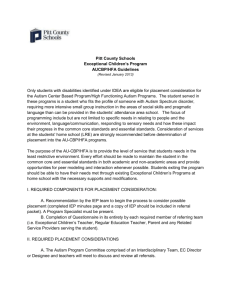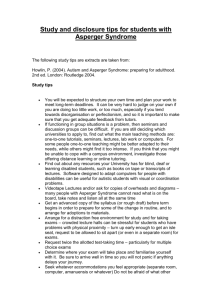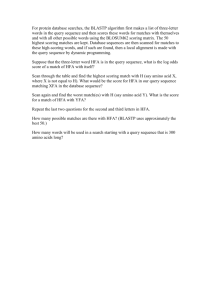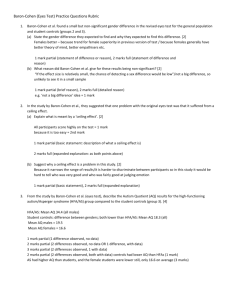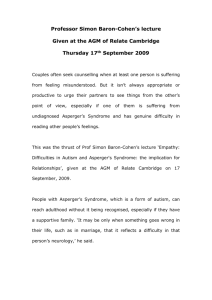powerpoint
advertisement
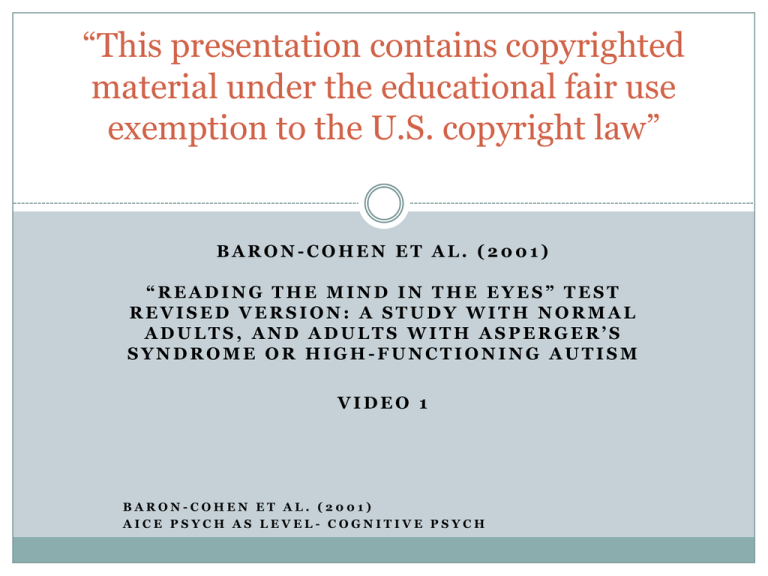
“This presentation contains copyrighted material under the educational fair use exemption to the U.S. copyright law” BARON-COHEN ET AL. (2001) “READING THE MIND IN THE EYES” TEST REVISED VERSION: A STUDY WITH NORMAL ADULTS, AND ADULTS WITH ASPERGER’S SYNDROME OR HIGH-FUNCTIONING AUTISM VIDEO 1 BARON-COHEN ET AL. (2001) AICE PSYCH AS LEVEL- COGNITIVE PSYCH I. Background A. This study is a “redo” of a 1997 for various reasons (discussed later) B. Research into detecting autism with children 1. 1985- Sally-Anne Test- kids w/autism have a delayed Theory of Mind (ToM) 2. http://www.youtube.com/watch?v=QjkTQtggLH4 C. Baron-Cohen talks about the history of Autism & how genes and other factors may affect the disorder http://www.youtube.com/watch?v=crmDSDeCEp4 Cue 1: On the PPT edition of this lecture, enlarge the Sally-Anne picture on this slide and answer the two questions. Cue 2: Using the Baron-Cohen video link above, summarize the main points of discussion in 5 bullet points I. Background D. Research into detecting autism with adults 1. Aim in research focuses on developing “social sensitivity” tests that are sensitive enough to detect “subtle cognitive dysfunction” 2. Such tests are lacking for adults who have ‘normal’ IQ yet may have a deficiency in social understanding 3. Existing tests are typically for adults who suffered brain damage, not for neurodevelopmental conditions like autism and Asperger’s syndrome (AS) 4. Tests have to be sensitive enough to detect these shortcomings as adults may have learned how to compensate for them (thus tests not picking up on it) II. Original “Eyes Test” (1997) A. Theory of Mind (ToM) 1. Involves 2 stages of understanding someone else’s mindset a-stage 1- ability to attribute the relative mental state of another person (compassion) b- stage 2- ability to infer the content of that mental state (compassion for her mother’s loss) 2. *NOTE- Eyes Test ONLY involves stage 1 3. Also referred to as ‘social intelligence’ by Baron-Cohen II. Original “Eyes Test” B. Original test summary 1. Ps included normal, Asperger’s (AS) & high-functioning autism (HFA), and Tourett’s adults 2. Ps presented with a series of 25 photos of the eye-region of a face 3. Ps had to choose which of two words best describes what the person was thinking or feeling a. Purpose was to see how well they could understand a mental state 4. Baron-Cohen described this as an “advanced theory of mind test” II. Original “Eyes Test” (1997) C. Results of original “Eyes Test” 1. Succeeded in discriminating adults with AS & HFA from controls 2. Controls scored higher than AS/HFA adults 3. Results showed success in developing a test of social sensitivity to reveal subtle mind-reading difficulties in adults with AS &HFA 4. Results demonstrated that normal adults could judge mental states from even minimal cues (expressions from around the eyes) 5. Having established that testing for social sensitivity among controls and adults with autism was feasible, this then enabled Baron-Cohen to consider how to make the test better (overall purpose of this 2001 study) III. Problems with Original “Eyes Test” Problem 1 Problem: Forced choice of only 2 word responses- made for 50/50 performance on each trial, leading to too narrow of a range for significance Solution: Forced choice of 4 words in new Revised Eyes Test (R-ET) Problem 2 Problem: Parents of children with AS scored at about the same level as it may have been a result of too narrow range of items (25 initially) Solution: R-ET had 36 items (photos) to be scored III. Problems with Original “Eyes Test” Problem 3 Problem: Narrow range of scores and only 2 word options resulted in ceiling effects with too many scores in the top range (possibly skewing the results) Solution: Again, increased number of items to 36 and having 4 word choices per item instead Problem 4 Problem: Original test had both basic (easy) and complex (harder) mental states (such as anger vs. sarcastic) and posed the potential again for ceiling effects as too many Ps would get the emotion right Solution: Only complex mental states were used III. Problems with Original “Eyes Test” Problem 5 Problem: Some photos were too easily guessed correctly because of the gaze direction of the eyes, such as “ignoring” Solution: These items were excluded from the R-ET Problem 6 Problem: Original test had more female faces than male faces Solution: Equal number of male & female faces for better control of variables III. Problems with Original “Eyes Test” Problem 7 Problem: The original semantic word and foil (the other word) were semantic opposites (like sympathetic & unsympathetic) which could make the test too easy and lead to ceiling effects again. Solution: The 3 foils were similar in meaning (not semantic opposites), making each item more difficult and “maximising the possibility of revealing subtle individual differences” Problem 8 Problem: Some word choices may have not been understood by the Ps Solution: A glossary of terms was included in which Ps could refer to “This presentation contains copyrighted material under the educational fair use exemption to the U.S. copyright law” BARON-COHEN ET AL. (2001) “READING THE MIND IN THE EYES” TEST REVISED VERSION: A STUDY WITH NORMAL ADULTS, AND ADULTS WITH ASPERGER’S SYNDROME OR HIGH-FUNCTIONING AUTISM VIDEO 2 BARON-COHEN ET AL. (2001) AICE PSYCH AS LEVEL- COGNITIVE PSYCH IV. Aims of the Study 1. To test a group of adults with AS or HFA on the revised version of the Eyes Test to see if the results would be replicated Basically wanted to see if the R-ET fixed the problems or if it would produce the same results 2. To test if there is an negative correlation in a sample of normal adults between the R-ET and the Autism Spectrum Quotient (AQ) AQ measures the degree to which any person (adult) with a normal IQ possesses autistic traits (0-50, higher score = more autistic traits) 3. To test if there is a gender difference on the R-ET Basically to see if female superiority is replicated V. Participants A. Group 1 (AS/HFA) 15 male adults with AS/HFA Self-selecting from U.K. National Autistic Society magazine ad Normal IQ range (x=115) and mix of socioeconomics and education B. Group 2 (general population controls) 122 adults (as controls) from adult community & education classes from Exeter or from public library at Cambridge (no mention of Hogwarts) 55 males & 67 females Broad mix of occupations and education V. Participants Group 3 (students from Cambridge) 103 undergraduate students (71 in science and 32 in other majors) 53 males and 50 females Assumed to have higher IQ than other Ps (though not specified) Group 4 (IQ-matched controls) 14 randomly selected adults who were IQ-matched with Group 1 IQ x=116 No mention of gender (assuming male though) No mention of how selected/recruited VI. Hypotheses H1- The AS/HFA group would score significantly lower on the R-ET than the other groups, but would be unimpaired on gender control judgments H2- The AS/HFA group would score significantly higher on the AQ test than the other groups H3- Females in the control groups (groups 2 & 3) would score higher than males on the R-ET H4- Males in the student group (group 3) would score higher than females on the AQ test H5- Scores on the AQ and the R-ET would be negatively correlated VII. Procedure A. Design of the Study 1. Natural experiment IV= (1) AS/HFA or Control and (2) Gender DV= (1) R-ET score, (2) AQ score, and (3) gender identification for AS/HFA group 2. Apparatuses (Psychometric tests) a. Revised Eyes Test (given to all groups) b. AQ (given to AS/HFA, students, and IQ-matched groups) Was pencil and paper test with black & white photos Revised Eyes Test via Harvard http://kgajos.eecs.harvard.edu/mite/ AQ test link- http://aq.server8.org/ 3. Data collection= via pencil/paper questionnaires 4. Data type= quantitative only Cue 3: Take the computer-based R-ET via Harvard at the link above & report the score Cue 4: Take the AQ via the link above & report the score VII. Procedure B. Developing the Revised Eyes Test 1. Researcher Piloting a. Baron-Cohen & Wheelwright originated target words and foils for each photo that were then piloted on a group of 8 judges (4M&4F) b. For the target words and foils to get the ‘go ahead,’ at least 5 judges had to agree on the target word for each photo and no more than 2 judges could pick any single foil word c. If this happened, the target words and/or foils were re-piloted until the criteria was met for each VII. Procedure 2. Using the R-ET with control groups (groups 2&3) a. The control groups were the first groups tested with the original 40 photos and did not differ much in their results b. The data from these two groups were than combine N= 225 c. Researchers then looked at data for each item and eliminated 4 items overall, leaving 36 of them 1. The data ultimately presented for the control groups (2&3) were only based on these 36 items d. From the results of this large data set, the AS/HFA and IQmatched groups would then take the now 36 item R-ET CUE 5: Explain the criteria used that led to the elimination of the 4 items from the 40 question test. “This presentation contains copyrighted material under the educational fair use exemption to the U.S. copyright law” BARON-COHEN ET AL. (2001) “READING THE MIND IN THE EYES” TEST REVISED VERSION: A STUDY WITH NORMAL ADULTS, AND ADULTS WITH ASPERGER’S SYNDROME OR HIGH-FUNCTIONING AUTISM VIDEO 3 BARON-COHEN ET AL. (2001) AICE PSYCH AS LEVEL- COGNITIVE PSYCH VII. Procedure C. Implementing the tests 1. Each test was individually administered in a quiet room at either Cambridge or Exeter 2. The AS/HFA group had to judge the gender of each photo as a control task (not done for others as piloting had ceiling effects) 3. Ps in groups 1, 3, & 4 completed the AQ test 4. Ps were asked to read through the glossary of terms and to ask questions as needed to ensure that each understood the term (to eliminate extraneous variables) and could use the glossary as needed during the test VIII. Results (Scores overall ranged from 17-35, with a mode of 24) 1. The AS/HFA group performed significantly worse than the other groups (H1 supported) 2. On the AQ test, the AS/HFA group scored significantly higher than the control groups (g3 & g4) (H2 supported) AS/HFA score X= 21.9 to X=26.2 (g2), 28.0 (g3), and 30.9 (g4) AS/HFA score X=34.4 to X= 18.3 (g3) and X= 18.9 (g4) 3. Females scored higher on the R-ET (not sig.) (H3 supported) Cue 6- Document this result from both groups 4. Males scored higher on the AQ test (non sig.) (H4 supported) Cue 7- Document this result from both groups 5. There was a significant negative correlation (-0.53) b/w scores on AQ and R-ET (H5 supported) IX. Discussion & Conclusions 1. Current study replicated finding of previous test that AS/HFA adults are significantly impaired in identifying social interaction cues. 2. Current study reconfirmed that AS/HFA adults score significantly higher on the AQ test than the general population. 3. The modifications made enabled the R-ET to be more sensitive in the measurement of adult social intelligence 4. The results of the study demonstrated that the R-ET is useful in identifying impairments related to AS/HFA 5. Gender differences on the R-ET most likely would have been significant if the sample was larger X. Strengths & Weaknesses A. Strengths 1. Quantitative data from rather large sample 2. The R-ET is easy to administer and replicable 3. Pilot evaluations of target words & foils with researchers 4. Pilot testing of original 40 questions with controls 5. Experimental validity- measures autistic traits 6. No main ethical concerns B. Weaknesses 1. Mainly ecological validity Testing done in a room is different than the everyday context that you would encounter in social settings Looking at B&W photos of still eyes is very different than one would encounter in social settings The Fun Continues… Cue 8: From the ARTICLE ITSELF, explain how the Revised Eyes Test may be relevant for other clinical groups beyond the autistic spectrum. [4] Cue 9: Baron-Cohen et al. (eyes test) investigated identifying social cues in adults with autism and adults without autism. Explain two ways in which the findings of this study are useful. [4] Cue 10: Discuss two ways how the Baron-Cohen et al. (eyes test) study applies to the cognitive approach. [4] TASK: From the ARTICLE ITSELF by Baron-Cohen et al., provide T/F questions as noted below. If the answer is false, provide the correct answer alongside. -Introduction/Background: 4 questions (2T/2F) -Problems with Original Test: 10 questions (5T/5F) -Method: 6 questions (3T/3F) -Results: 5 questions (2T/3F) -Discussion: 5 questions (3T/2F)
